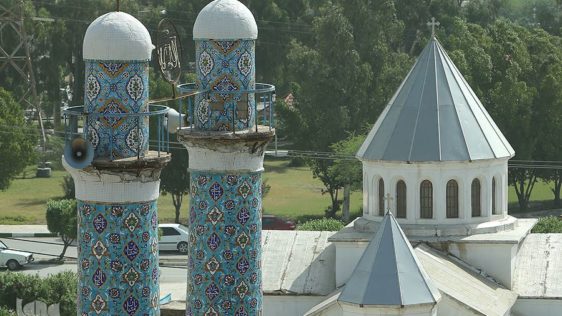Abadan : Church and Mosque Side by Side
The Two Sacred Places Stand Side by Side - Indicating Friendship and Fraternity Between the Followers of the Two Religions.
November 6th, 2016

The “Karapet” Church, which was built by Armenians in the southern port city of Abadan in 1958 is located in the center of the city. Before the construction of the new building there was another church building in which the Armenians living in Abadan performed their religious ceremonies.
In the neighborhood of the church there stands one of the oldest mosques of the city. The mosque is named “Masjid Musa-ibn-Jafar” after the 7th Imam of Shia’ Muslims. Old and distinguished clergymen of the city believe that the church had been established before the mosque. Father Ruben Manokian, the church’s pastor, says, “there are only two or three churches worldwide built wall to wall to a mosque.”
The two sacred places standing side by side indicate friendship and fraternity between the followers of the two religions. Muslims and Christians, ever since the very first days when the holy religion of Islam was introduced to the world, have been living in peace and on friendly terms in every part of the world including Iran.
The architectural style of the `Karapet’ church reminds one of old churches. It is built in the most traditional form possible. The style was adopted from the first church built in a city located in lands presently belonging to Armenia.

The beautiful design around the church, the round columns, and bronze conical-shaped domes of the church add to its magnificence and contribute to the beauty of the city of Abadan. Many religious icons and statues including the cross of Jesus Christ [Propet Isa (AS)] at the top of the domes, the bells and the tower, each contribute to the spiritual atmosphere in the church.
The name, date of the establishment and other information on the church, are inscribed in one sentence, above its southern entrance. According to the inscription the word “Karapet”, which originates from the Armenian language, means “The Messenger of Glad Tidings”.
The old architectural style of the building which stands close to modern and new buildings recently built in the city, highlights the promximity of the city’s old and new architectural styles. This closeness surpasses the architecture of the buildings and serves as a standing proof of the fraternity between the two nations of Iran and Armenia. The minarets of the mosque, which rise to the sky in the same direction as the conical domes of the church indicate the oneness of the route to Allah adopted by both Muslims and the Christians.

The outer walls of the church are decorated with very beautiful plaster columns with several windows worked artfully in between them. The inner space of the church is lit with many large lanterns.
The church was reopened by the Armenians on Christmas 1998 after being rebuilt. It had been heavily bombed by Iraqi war-planes during the Iraqi Baath regime’s imposed war and it was severely damaged.
Father Ruben Manokian says, “I was born in Abadan 50 years ago. As far as I can remember, I’ve always attended this church together with my family to perform my religious duties.”
The church used to be attended by hundreds of Armenians before the war. We enjoy the same rights as the city’s Muslims and have equal social rights. Even with regards to the political rights, we are the same. We have got our own representatives in the Majlis (Parliament) and have our children brought up in our own educational system, in our own language.
A young Armenian lady commenting on the point, remarks, “I, like any other Muslim girl, am freely studying at university. I would like to express my gratitude to the Iranian authorities for their creating an atmosphere of freedom for us, which encourages our friendly feelings toward other Muslim Iranians and makes us feel at home in our own country, Iran. As an Armenian, I am free to attend the church, study at university, vote in all elections and practice any kind of job I choose.”

According to the clergyman, there is a stone tablet set up beside the southern entrance to the church in commemoration of those Armenians killed by the Ottoman government on April 24,1915.
A lady with a baby in her arms is carved on the stone. The lady symbolizes the Mother of the Armenian nation. The extension of her skirt indicates the continuation of the genocide once carried out by the Ottomans. One sentence is also carved on the tablet in Armenian letters:
“We will always remember you, wherever we may be, in every time and every place. May God bless you.”
